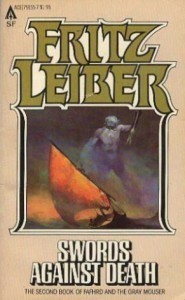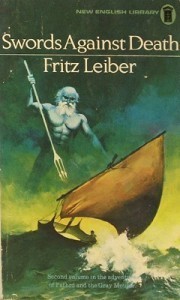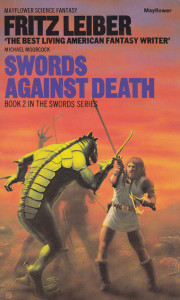Swords Against Death Re-Read: “The Howling Tower”
 Bill Ward and I are re-reading a book from Fritz Leiber’s famous Lankhmar series, Swords Against Death. We hope you’ll pick up a copy and join us. This week we tackled the fifth tale in the volume, “The Howling Tower.”
Bill Ward and I are re-reading a book from Fritz Leiber’s famous Lankhmar series, Swords Against Death. We hope you’ll pick up a copy and join us. This week we tackled the fifth tale in the volume, “The Howling Tower.”
Howard: In the overall run of Fafhrd and Gray Mouser episodes, this is a filler. That said, it’s a strong one, and holds up much better than, say “The Circle Curse” or even “The Bleak Shore” from last week. Having written to word count limits several times at this point, I couldn’t help feeling that’s what Leiber might have done here. He had a few thousand words worth of room to tell a story, so he kept it short and sweet. Or, possibly, he needed a quick check. Either way, what we got was fairly simple (though that doesn’t mean it wasn’t well executed). Consider the structure: 1. The setup, with the tower and the landscape and the howling. 2. Fafhrd’s disappearance and the Mouser’s pursuit. 3. The Mouser reaches the tower and the villain monologues. 4. The Mouser forces the villain into the nightmare realm with him. 5. The villain gets what’s coming to him.
Bill: I agree, I also noticed how concise the story was. The same basic elements could have gone into a longer story, one that culminated in an otherworldly combat with the spectral hounds, but instead it’s condensed right down into an effective little ghost story.
 Howard: Right! It’s still pretty satisfying. Sure, it isn’t a great one like “Thieves’ House” or some of those coming up, but it fires on full cylinders all the way. The mystery and the danger are well presented, and I was actually afraid for Fafhrd, despite knowing he was going to come out okay. Leiber even makes the monologue work, which is a helluva thing. In lesser hands it would have been much more of an info dump. Leiber almost manages to make that rant completely about character even as the bad guy’s telling us everything we need to know about the setup.
Howard: Right! It’s still pretty satisfying. Sure, it isn’t a great one like “Thieves’ House” or some of those coming up, but it fires on full cylinders all the way. The mystery and the danger are well presented, and I was actually afraid for Fafhrd, despite knowing he was going to come out okay. Leiber even makes the monologue work, which is a helluva thing. In lesser hands it would have been much more of an info dump. Leiber almost manages to make that rant completely about character even as the bad guy’s telling us everything we need to know about the setup.
Bill: That struck me as well, learning so much about the villain — and I didn’t even spot it as set up for the end. The description of the killing of the hounds was vivid and chilling and really got my attention. Leiber is very good at that sort of thing.
Howard: He sure is. I didn’t see the scaffolding the first times I read this story — I was quite swept up by it. Now I can wonder how it was done, and under what constraints, and I see that Leiber didn’t have word space or inclination to spread out and deliver a more detailed story. But what he gave us works very well, thank you. I’m glad he gave us more, and pieces that were better developed, but this was enjoyable.
 Bill: Short as it was he still had some time for some wonderful character moments — Fafhrd’s rather poetic invitation to “the wolves” to come share their fire, The Gray Mouser’s repulsion at having so terrified the old madman that he says he would have preferred simply killing him instead. The quick but none-the-less vivid details in the old man’s backstory also give a great explanation for a very common trope — this lone magician living in a haunted tower actually has a whole history leading up to that, all of which makes good sense. Even though it’s a quick story, it provides plenty of memorable images and moments.
Bill: Short as it was he still had some time for some wonderful character moments — Fafhrd’s rather poetic invitation to “the wolves” to come share their fire, The Gray Mouser’s repulsion at having so terrified the old madman that he says he would have preferred simply killing him instead. The quick but none-the-less vivid details in the old man’s backstory also give a great explanation for a very common trope — this lone magician living in a haunted tower actually has a whole history leading up to that, all of which makes good sense. Even though it’s a quick story, it provides plenty of memorable images and moments.
Howard: Next week we move on to one I re-read an awful lot, usually right before I’d read the story that follows it, which is a real favorite (“The Seven Black Priests”). On to “The Sunken Land.” Hope to see you here.
 newest »
newest »
Howard Andrew Jones's Blog
- Howard Andrew Jones's profile
- 368 followers




Unlike the Bleak Shore, however, this is a much more skilfully woven tale, with better dynamics and a more consistent tone. It just _feels_ more like a proper story. Where the Bleak Shore covered a large period of time from a remove, the Howling Tower is much more immediate and all the better for it. We get right into the heart of the action and experience events from the POV of the protagonists themselves. No third parties narrating to fourth parties etc.
Where I think this works so well is that Leiber strikes that magic balance between action and atmospherics. Later Lankhmar stories tended to become too plot/character driven and lost that horror edge of his earlier stuff, which in turn could be somewhat uneven plot-wise. In the Howling Tower, Leiber combines the humor, the horror, the magic and the swordplay in perfect doses. It is in essence the perfect Sword and Sorcery tale.
A side note: despite his short screen-time I found the villain to be a highly complex and memorable character. His repulsive physical appearance coupled with his obviously deranged state of mind from being cooped up alone in the tower for years on end made him a figure both pitiable and repulsive, a fact which made his death somewhat bittersweet.